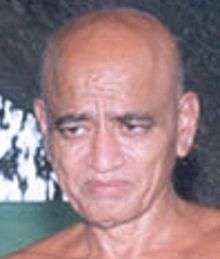Vidyasagar (Jain monk)
| Vidyasagar | |
|---|---|
| Digambara Acharya | |
 Acharya Vidyasagar | |
| Name (official) | Acharya Shri Vidyasagar Ji Maharaj |
| Personal Information | |
| Born |
Vidyadhar 10 October 1946 Sadalga, Belgaum district, Karnataka |
| Parents | Mallappa & Shrimati |
| Initiation | |
| Initiated by | Acharya Gyansagar |
| Initiated on | 30 June 1968 |
| After Initiation | |
| Preceded by | Acharya Gyansagar |
| Website |
www |
| Part of a series on |
| Jainism |
|---|
 |
|
Jain Prayers |
|
Practice |
|
Major figures |
|
Major Sects |
|
Festivals |
|
Pilgrimages |
| Jainism portal |
Acharya Shri Vidyasagarji Maharaj (Kannada:ಆಚಾರ್ಯ ವಿದ್ಯಾಸಾಗರ, Nagari:आचार्यश्री विद्यासागरजी महाराज) is one of the best known modern Jain Acharya.[1] He is known both for his scholarship and tapasya.[2] Despite of being in a modern age, he is known for his hard austerity and long hours in meditation.
Biography
He was born as Vidyadhar on 10 October 1946 on sharad Purnima in Sadalga, District Belgaum, Karnataka. His father was Shri Mallappa, who later became Muni Mallisagar. His mother Shrimati later became Aryika Samayamati.
He was initiated as a monk at the age of twenty-two by Acharya Gyansagar, who belonged to the lineage of Acharya Shantisagar, at Ajmer in 1968.[3] He was elevated to the Acharya status in 1972.[2]
Acharya Vidyasagara is an expert in Sanskrit, Prakrit and several modern languages such as Hindi, Marathi and Kannada. He has been a prolific author in Hindi and Sanskrit. Several researchers have studied his works for masters and doctoral degrees.[4] His works include Niranjana Shataka, Bhavana Shataka, Parishah Jaya Shataka, Suniti Shataka and Shramana Shataka. He also authored nealy 700 Haiku poems which are unpublished. He authored the Hindi epic poem Mukamati.[2][4] This has been also included in the syllabus of MA Hindi in various institutions.[5] This epic poem has also been translated into English by Mr. Lal Chandra Jain and was presented to President of India.[4][6][7]

Acharya Vidyasagar has been a source of inspiration to the people for starting institutions for the welfare of living beings at different places.[2]
Acharya Vidyasagar has been a source of inspiration for religious functions. He has initiated more than 125 monks,[8][9] a number unmatched in the past nine centuries. Several Panch kalyanak and Gajrath Mahotsava have been organized at different places of the country in his presence like Vidisha, Drongiri, Chattarpur (M.P), Bina Baraha Sagar (M.P), Morena (M.P), Madanganj Kishangarh Ajmer Raj, khajurahro, kundalgri, koniji, Jabalpur Padmanabhpur - Durg (CG) etc.
Acharya Vidyasagar has been a source of inspiration for the construction, development and renovation of Jain temples and images all over India.[2][2] He has always inspired to invite scholars of eminence to have discourses on different subjects. He has also taken classes to teach his disciples different Jain texts. He is a strong supporter of cow protection movement.[10]
His tradition
He belongs to the tradition established by Acharya Shantisagar. Acharya Shantisagar initiated Acharya Virasagar, who was then succeeded by Acharya Shivsagar, Acharya Gyansagar and finally Acharya Vidyasagara. Two of his brothers, Muni Yogasagar and Muni Samaysagar also followed him and were initiated as muni (monks) by Acharya Vidyasagar. Some of his disciples are well known scholars of their own right. As of 2001, about 21% of all the Digambar monks were under Acharya Vidyasagara.[11][12]
See also
Notes
- ↑ Flügel 2006, p. 353
- 1 2 3 4 5 6 Shah 1998, pp. 56–57
- ↑ "Aacharya Shri 108 Vidhya Sagar Ji Maharaj". jinaagamsaar.com. Retrieved 9 August 2015.
- 1 2 3 "Acharya Vidyasagar's book "Silent Earth" presented to President". News.webindia123.com. Retrieved 2012-12-12.
- ↑ http://www.bhaskar.com/article/MPc-58-1943771-NOR.html
- ↑ "Acharya Vidyasagar's Book "Silent Earth" Presented To President". jainworld.com.
- ↑ Vidyasagar, Acharya (2010), Lal Chandra Jain, ed., The Silent Earth [Mūkamāṭī], Moortidevi Granthamala: English Series No. 22, New Delhi: Bharatiya Jnanpith, ISBN 978-81-263-1875-9
- ↑ Studies in Jaina History and Culture: Disputes and Dialogues - Google Books. Books.google.com. Retrieved 2012-12-12.
- ↑ "Religious intolerance, terror attacks threat for country: Acharya - Oneindia News". News.oneindia.in. 2008-10-05. Retrieved 2012-12-12.
- ↑ Flügel 2006, p. 353.
- ↑ Flügel 2006, p. 356
- ↑ "Jain Muni Pramansagar ji Maharaj disciple of Acharya Vidyasagar ji Maharaj. - The Times of India". Timesofindia.indiatimes.com. 2010-10-27. Retrieved 2012-12-12.
References
- Shah, Natubhai (1998). Jainism: The World of Conquerors. Volume I and II. Sussex: Sussex Academy Press. ISBN 1-898723-30-3.
- Kshamasagar, Muni (2007). In Quest of Self : The life story of Acharya Shri Vidyasagar. Delhi: Bhartiya Jnanpith. ISBN 81-263-1166-5.
- Flügel, Peter (2006), Studies in Jaina History and Culture: Disputes and Dialogues, Taylor & Francis, ISBN 978-0-203-00853-9
Further reading
- Vidyasagar, Acharya, Mook Maati, Bhartiya Jnanpith, ISBN 978-81-263-1436-2
- Vidyasagar, Acharya (2010), Lal Chandra Jain, ed., The Silent Earth [Mūkamāṭī], Moortidevi Granthamala: English Series No. 22, New Delhi: Bharatiya Jnanpith, ISBN 978-81-263-1875-9
- Mācave, Prabhākara; Rāmamūrti, Tripāṭhī, Mūkamāṭī-Mīmāṃsā (in Hindi), 1, 2 & 3, Bhartiya Jnanpith
| ||||||||||||||||||||||||||||||||||||||||||||||
| ||||||||||||||||||||||||||||||||||||||||||||||||||||||||||||||||||||||